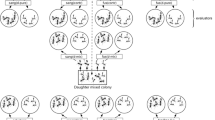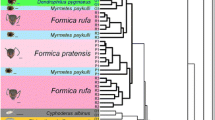Abstract
Slave-making ants exploit the worker force of host colonies permanently and have to make recurrent raids in order to replenish the slave’s stock. Some of these parasite species exploit different host species and few studies so far have been devoted to host species recognition mechanisms. Here, we tried to determine if opportunist slave-making ants using different host species rely on innate or experience-induced preferences to discriminate host from non-host species. We show that Myrmoxenus ravouxi slave-making workers are not only more aggressive toward heterocolonial host and potential host species workers when compared with non-host species workers, but also toward heterocolonial host workers than toward heterocolonial conspecifics. Moreover, M. ravouxi workers display more antennations and contacts toward the heterocolonial host species when compared with the non-host species. We also show that they do not discriminate between homocolonial and heterocolonial conspecifics. Together, our results suggest that this opportunistic slave-making ant species may have a complex social recognition template based on both innate and experience-based mechanisms.



Similar content being viewed by others
References
Alloway T.M. 1980. The origins of slavery in leptothoracine ants (Hymenoptera: Formicidae). Am. Nat. 115: 247-261
Baur A., Chalwatzis N., Buschinger A. and Zimmermann F.K. 1995. Mitochondrial DNA sequences reveal close relationships between social parasitic ants and their host species. Curr. Genet. 28: 242-247
Beibl J., Stuart R.J., Heinze J. and Foitzik S. 2005. Six origins of slavery in formicoxenine ants. Insect. Soc. 52: 291-297
Blatrix R. and Herbers J.M. 2003. Coevolution between slave-making ants and their hosts: host specificity and geographical variation. Mol. Ecol. 12: 2809-2816
Bonavita-Cougourdan A., Rivière G., Provost E., Bagnères A.G., Roux M., Dusticier G. and Clément J.L. 1996. Selective adapation of the cuticular hydrocarbon profiles of the slave-making ants Polyergus rufescens Latr. and their Formica rufibarbis Fab. and F. cunicularia Latr. slaves. Comp. Biochem. Physiol. B Biochem. Mol. Biol. 113: 313-329
Bonavita-Cougourdan A., Bagnères A.G., Provost E., Dusticier G. and Clément J.L. 1997. Plasticity of the cuticular hydrocarbon profile of the slave-making ant Polyergus rufescens depending on the social environment. Comp. Biochem. Physiol. B Biochem. Mol. Biol. 116: 287-302
Brandt M. and Foitzik S. 2004. Community context and specialization influence coevolution between a slavemaking ant and its hosts. Ecology 85: 2997-3009
Brandt M., Heinze J., Schmitt T. and Foitzik S. 2005. A chemical level in the coevolutionary arms race between an ant social parasite and its hosts. J. Evol. Biol. 18: 576-586
Buschinger A., Ehrhardt W. and Winter U. 1980. The organization of slave raids in dulotic ants - a comparative study (Hymenoptera; Formicidae). Z. Tierpsychol. 53: 245-264
Buschinger A. and Winter U. 1983. Population studies of the dulotic ant, Epimyrma ravouxi, and the degenerate slavemaker, E. kraussei (Hymenoptera: Formicidae). Entomol. Gen. 8: 251-266
Buschinger A. 1986. Evolution of social parasitism in ants. Trends Ecol. Evol. 1: 155-160
Buschinger A. 1989. Evolution, speciation, and inbreeding in the parasitic ant genus Epimyrma (Hymenoptera, Formicidae). J. Evol. Biol. 2: 265-283
Buschinger A. 1997. Socially parasitic formicoxenine ants from Western Europe—a review (Hymenoptera, Formicidae). In: Proc. Int. Coll. Social Insects (Kipyatkov V.E., Ed), vol 3-4. Russian Language Section of the IUSSI, Socium, St. Petersburg, pp 1-9
Buschinger A. 2009. Social parasitism among ants: a review (Hymenoptera: Formicidae). Myrmecol. News 12: 219-235
Cao T.T. and Dornhaus A. 2012. Ants use pheromone markings in emigrations to move closer to food-rich areas. Insect. Soc. 59: 87-92
Crosland M.W.J. 1989. Kin recognition in the ant Rhytidoponera confusa. I. Environmental odour. Anim. Behav. 37: 912-919
Crozier R.H. and Dix M.W. 1979. Analysis of two genetic models for the innate components of colony odor in social Hymenoptera. Behav. Ecol. Sociobiol. 4: 217-224
d’Ettorre P., Mondy N., Lenoir A. and Errard C. 2002. Blending in with the crowd: social parasites integrate into their host colonies using a flexible chemical signature. Proc. R. Soc. London B Biol. Sci. 269: 1911-1918
Emery C. 1909. Über den Ursprung der dulotischen, parasitischen und myrmekophilen Ameisen. Biol. Centralbl. (Berlin) 29: 352-362
Errard C. 1994. Development of interspecific recognition behavior in the ants Manica rubida and Formica selysi (Hymenoptera: Formicidae) reared in mixed-species groups. J. Insect Behav. 7: 83-99
Errard C. and Hefetz A. 1997. Label familiarity and discriminatory ability of ants reared in mixed groups. Insect. Soc. 44: 189-198
Errard C., Hefetz A. and Jaisson P. 2006. Social discrimination tuning in ants: template formation and chemical similarity. Behav. Ecol. Sociobiol. 59: 353-363
Fischer B. and Foitzik S. 2004. Local co-adaptation leading to a geographical mosaic of coevolution in a social parasite system. J. Evol. Biol. 17: 1026-1034
Fischer-Blass B., Heinze J. and Foitzik S. 2006. Microsatellite analysis reveals strong but differential impact of a social parasite on its two host species. Mol. Ecol. 15: 863-872
Foitzik S. and Heinze J. 1998. Nest site limitation and colony take over in the ant, Leptothorax nylanderi. Behav. Ecol. 9: 367-375
Foitzik S., Deheer C.J., Hunjan D.N. and Herbers J.M. 2001. Coevolution in host-parasite systems: behavioural strategies of slave-making ants and their hosts. Proc. R. Soc. London B Biol. Sci. 268: 1139-1146
Foitzik S., Fischer B. and Heinze J. 2003. Arms-races between social parasites and their hosts: Geographic patterns of manipulation and resistance. Behav. Ecol. 14: 80-88
Franks N., Blum M., Smith R.K. and Allies A.B. 1990. Behavior and chemical disguise of cuckoo ant Leptothorax kutteri in relation to its host Leptothorax acervorum. J. Chem. Ecol. 16: 1431-1444
Franks N.R, Dornhaus A., Hitchcock G., Guillem R., Hooper J. and Webb C. 2007a. Avoidance of conspecific colonies during nest choice by ants. Anim. Behav. 73: 525-534
Franks N.R, Hooper J.W, Dornhaus A., Aukett P.J, Hayward A.L. and Berghoff S.M. 2007b. Reconnaissance and latent learning in ants. Proc. R. Soc. London B Biol. Sci. 274: 1505-1509
Hare J.F. and Alloway T.M. 2001. Prudent Protomognathus and despotic Leptothorax duloticus: differential costs of ant slavery. Proc. Natl Acad. Sci. U.S.A. 98: 12093-12096
Heinze J., Foitzik S., Hippert A. and Hölldobler B. 1996. Apparent dear-enemy phenomenon and environment-based recognition cues in the ant Leptothorax nylanderi. Ethology 102: 510-522
Isingrini M., Lenoir A. and Jaisson P. 1985. Preimaginal learning as a basis of colony-brood recognition in the ant Cataglyphis cursor. Proc. Natl Acad. Sci. U.S.A. 82: 8545-8547
Kaib M., Heinze J. and Ortius D. 1993. Cuticular hydrocarbons profiles in the slave-making ant Harpogoxenus sublaevis and its hosts. Naturwissenschaften 80: 281-285
Knaden M. and Wehner R. 2003. Nest defense and conspecific enemy recognition in the desert ant Cataglyphis fortis. J. Insect Behav. 16: 717-730
Kronauer D.J.C., Gadau J. and Hölldobler B. 2003. Genetic evidence for intra- and interspecific slavery in honey ants (genus Myrmecocystus). Proc. R. Soc. London B Biol. Sci. 270: 805-810
Le Moli F., Grasso D.A, d’Ettorre P. and Mori A. 1993. Intraspecific slavery in Polyergus rufescens Latr. (Hymenoptera, Formicidae): field and laboratory observations. Insect. Soc. 40: 433-437
Lenoir A., Fresneau D., Errard C. and Hefetz A. 1999. Individuality and colonial identity in ants: the emergence of the social representation concept. In: Information Processing in Social Insects (Detrain C., Deneubourg J.L. and Pasteels J., Eds), Birkhäuser Verlag, Basel. pp 219-237
Lenoir A., D’Ettorre P., Errard C. and Hefetz A. 2001. Chemical ecology and social parasitism in ants. Annu. Rev. Entomol. 46: 573-599
Liang D. and Silverman J. 2000. “You are what you eat”: Diet modifies cuticular hydrocarbons and nestmate recognition in the Argentine ant, Linepithema humile. Naturwissenschaften 87: 412-416
Parker J.D. and Rissing S.W. 2002. Molecular evidence for the origin of workerless social parasites in the ant genus Pogonomyrmex. Evolution 56: 2017-2028
Pollock G.B. and Rissing S. W. 1989. Intraspecific brood raiding, territoriality, and slavery in ants. Am. Nat. 133: 61-70
Reeve H.K. 1989. The evolution of conspecific acceptance thresholds. Am. Nat. 133: 407-435
Sanada-Morimura S., Minai M., Yokoyama M., Hirota T., Satoh T. and Obara Y. 2003. Encounter-induced hostility to neighbors in the ant Pristomyrmex pungens. Behav. Ecol. 14: 713-718
Schumann R.D. 1992: Raiding behavior of the dulotic ant Chalepoxenus muellerianus (Finzi) in the field (Hymenoptera: Formicidae, Myrmicinae). Insect. Soc. 39: 325-333
Schumann R.D. and Buschinger A. 1995. Imprinting effects on host-selection behavior of slave-raiding Chalepoxenus muellerianus (Finzi) workers (Hymenoptera: Formicidae). Ethology 99: 243-251
Seifert B. 2007. Die Ameisen Mittel- und Nordeuropas. Lutra Verlags- und Vertriebsgesellschaft, Tauer
Soroker V., Vienne C., Hefetz A. and Nowbahari E. 1994. The postpharyngeal gland as a “Gestalt” organ for nestmate recognition in the ant Cataglyphis niger. Naturwissenschaften 81: 510-513
Soroker V., Lucas C., Simon T., Fresneau D., Durand J.L. and Hefetz A. 2003. Hydrocarbon distribution and colony odour homogenisation in Pachycondyla apicalis. Insect. Soc. 50: 212-217
Stuart R.J. and Alloway T.M. 1982. Territoriality and the origin of slave raiding in leptothoracine ants. Science 215: 1262-1263
Sturgis S.J. and Gordon D.M. 2012. Nestmate recognition in ants (Hymenoptera: Formicidae): a review. Myrmecol. News 16: 101-110
Sumner S., Aanen D.K., Delabie J. and Boomsma J.J. 2004. The evolution of social parasitism in Acromyrmex leaf-cutting ants: a test of Emery’s rule. Insect. Soc. 51: 37-42
Thompson J.N. 1994. The Coevolutionary Process. The University of Chicago Press, Chicago
van Zweden J.S., Dreier S. and d’Ettorre P. 2009a. Disentangling environmental and heritable nestmate recognition cues in a carpenter ant. J. Insect Physiol. 55: 158-163
van Zweden J.S., Heinze J., Boomsma J.J. and d'Ettorre P. 2009b. Ant queen egg-marking signals: matching deceptive laboratory simplicity with natural complexity. PLoS ONE 4: e4718
van Zweden J.S. and d’Ettorre P. 2010. Nestmate recognition in social insects and the role of hydrocarbons. In: Insect Hydrocarbons: Biology, Biochemistry and Chemical Ecology (Blomquist G.J. and Bagnères A.G., Eds). Cambridge University Press, Cambridge. pp 222-243
Wilson E.O. 1975. Slavery in ants. Sci. Am. 232: 32-36
Winter U. 1979. Epimyrma goesswaldi Menozzi, eine sklavenhaltende Ameise. Naturwissenschaften 66: 581-582
Acknowledgments
Olivier Delattre was supported by the French Ministry of Research. Nicolas Châline and Stéphane Chameron were supported by the ANR project SEUILS ANR-09-JCJC-0031.
Author information
Authors and Affiliations
Corresponding author
Rights and permissions
About this article
Cite this article
Delattre, O., Châline, N., Chameron, S. et al. Opportunist slave-making ants Myrmoxenus ravouxi discriminate different host species from a non-host species. Insect. Soc. 60, 7–13 (2013). https://doi.org/10.1007/s00040-012-0257-3
Received:
Revised:
Accepted:
Published:
Issue Date:
DOI: https://doi.org/10.1007/s00040-012-0257-3




